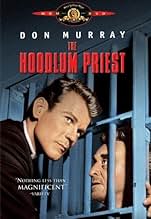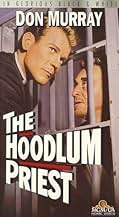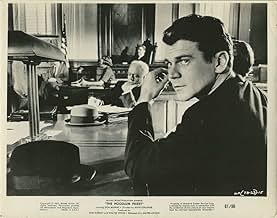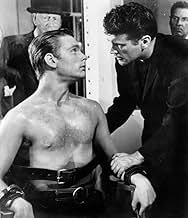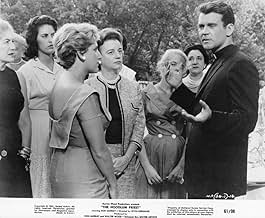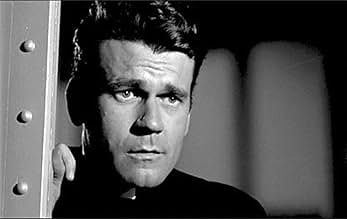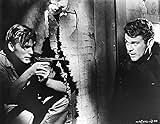Ajouter une intrigue dans votre langueBased on the life of Fr. Charles Clark, a minister to street gangs.Based on the life of Fr. Charles Clark, a minister to street gangs.Based on the life of Fr. Charles Clark, a minister to street gangs.
- Réalisation
- Scénario
- Casting principal
- Récompenses
- 2 victoires et 1 nomination au total
Norman McKay
- Father Dunne
- (as Norman MacKaye)
Walter L. Wiedmer
- Father David Michaels
- (as Walter Wiedmer)
Avis à la une
Father Charles Dismas Clark was by all accounts an extraordinary man and at least 30 years older than Don Murray who played him in The Hoodlum Priest. He came from a working class coal mining background in Pennsylvania, his ancestors were Molly Maguires. Not the kind to rise in the Catholic Church and he didn't. He died only two years after The Hoodlum Priest came out. But two years before Clark founded Dismas House, the first halfway house for newly released criminals from prison. Though I'm sure each state has its different standards, Dismas House became the prototype for such programs.
Murray plays the jive talking priest who speaks the language of the streets and gains the trust of the hoodlum element by doing so. It's the portrayal of a deeply dedicated man to his cause of ministering to a class of people not usually thought of as Christian material. Murray also produced this independent film released by United Artists on a shoe string budget that went way overboard for clearly a B picture.
In an article I read about the film Murray was in St. Louis promoting one of his films when a priest literally accosted him at the premiere and it was Father Clark. Fascinated by the man Murray agreed to do the film and set about to find the cast and financing for Hoodlum Priest.
Larry Gates plays a criminal attorney who helps Murray with setting up and financing Dismas House. In helping Murray realize his dream Gates' role is not all that different from Henry Hull's in Boystown.
Another plot thread is taken from the Pat O'Brien film Fighting Father Dunne where O'Brien is also trying found a home for orphans like Spencer Tracy in Boystown. Keir Dullea plays a troubled youth in his breakthrough role and Darryl Hickman plays the same kind of part in Fighting Father Dunne. In both films it was the failure here that contrasts the overall success. Both Hickman and Dullea have tragic and identical ends. Murray's facial reactions at Dullea's death is a priceless bit of acting without dialog.
Hoodlum Priest is a fine film a great example of what just a few dollars will get you with the right script, direction, and playing. Even if it put a few gray hairs in Murray's head when it went over budget.
Murray plays the jive talking priest who speaks the language of the streets and gains the trust of the hoodlum element by doing so. It's the portrayal of a deeply dedicated man to his cause of ministering to a class of people not usually thought of as Christian material. Murray also produced this independent film released by United Artists on a shoe string budget that went way overboard for clearly a B picture.
In an article I read about the film Murray was in St. Louis promoting one of his films when a priest literally accosted him at the premiere and it was Father Clark. Fascinated by the man Murray agreed to do the film and set about to find the cast and financing for Hoodlum Priest.
Larry Gates plays a criminal attorney who helps Murray with setting up and financing Dismas House. In helping Murray realize his dream Gates' role is not all that different from Henry Hull's in Boystown.
Another plot thread is taken from the Pat O'Brien film Fighting Father Dunne where O'Brien is also trying found a home for orphans like Spencer Tracy in Boystown. Keir Dullea plays a troubled youth in his breakthrough role and Darryl Hickman plays the same kind of part in Fighting Father Dunne. In both films it was the failure here that contrasts the overall success. Both Hickman and Dullea have tragic and identical ends. Murray's facial reactions at Dullea's death is a priceless bit of acting without dialog.
Hoodlum Priest is a fine film a great example of what just a few dollars will get you with the right script, direction, and playing. Even if it put a few gray hairs in Murray's head when it went over budget.
I was 13 when this film came out and while I don't know for sure why I never got to see this. I'm guessing, morals being what they were at the time; this was probably judged to rough a movie for a boy my age. It probably would have been a R rated movie in it's day. So when I saw it listed on Turner Classic Movies I thought great, I finally get a chance to see this old film. Well now that I've seen it I'm amazed this film gets so much buzz. I found it to be way to melodramatic, over acted and just plain hammy. I'm not sure how this could have ever been relevant. I know that Father Clark did great work in his time; but this seems a poor way to tell his story. Almost everyone in this movie is over acting. I'm guessing that's the fault of the director, but that doesn't make it any easier to sit through. I'm sure many will be drawn to this film by Keir Dullea's name in the cast. Dullea's fame comes from 2001 a film whose uniqueness at the time; pulled along most of the actors who happened to be in it. Like the Hoodlum Priest there were no great performances in that film either. A film for film school students, theater majors, and nostalgia buffs. A corny waste of time.
Irv Kerschner, who was George Lucas' teacher at USC and later directed one of his pupil's Star Trek features, made this glossy well-meaning melodrama released by United Artists in 1961. Shot on location in St. Louis and featuring the semi-documentary but often overly self-conscious B&W cinematography of Haskell Wekler, the story is based on the real life story of a Jesuit priest --perhaps the first man in America to set up a half-way house for ex-cons. Although its heart is in the right place, and the film makes the plea that the criminal justice system in the United States only serves to criminalize young offenders rather than reform them, Kershner cannot resist all the obvious opportunities to be arty: chases through railroad yards and into abandoned buildings with broken furniture and boarded-up windows providing the right shadows on the wall. He also hammers home his point by squeezing out the last drop of melodrama from the shaky plot, including a totally implausible electric chair sequence with the priest admitted into the chamber as his hoodlum friend is about to be electrocuted. The film tries to have its cake and eat it, too. In real life the Irish priest was helped to build his halfway house by a Russian-Jewish immigrant attorney, Morris Shenker, but the film homogenizes their relationship; the young offenders somehow feel as if they dropped out of "West Side Story," made the same year, because they were unable to sing and dance.
A visit to the other side of the tracks is what to expect here keeping mind that this could be the story of anyone young, misguided and lost without direction and surrounded by temptation and hopelessness. With that mind, watch how everything can wrong (Murphy's law) and then some. This movie also takes us to the fine line of choice and how in a moment of weakness or impulse, one bad choice can bring your whole life crashing down. Can't happen to you...you say? That's who visits with first. Also anyone that has lived knows the truth of this statement. How many times have we all said to ourselves: there go I but for the grace of God? The movie drives this point home too. Ten cents or ten million, all face the same problems and at the same time all of us have the same remedy too i.e. HOPE. If you add prayer to that and a sincere effort, you can rise above just about anything. Why? We were not put here to be defeated. Some really good dialog and scenes that try to reach for your emotions. Let them! One more thing. If someone has nothing and they offered anything and that offer should be respected even if your ...
The true story of Jesuit priest Father Charles Dismas Clark and his struggles in opening a halfway house for recently-paroled convicts in '50s-era St. Louis. Lead actor Don Murray (who also co-produced the film and co-wrote the screenplay under a pseudonym) was reportedly inspired to tackle this project after meeting the real Father Dismas Clark, who is credited as technical adviser; still, one can see right away how this production got funded, what with a violent police standoff in the third act, capped with a dramatic gas chamber sequence. Despite talented Irvin Kershner as director and Haskell Wexler as cinematographer, the picture isn't any more weighty or profound than the juvenile delinquent programmers of the previous decade. Keir Dullea makes a strong debut as a troubled youth, but Murray and the other cast members generally fail to impress. *1/2 from ****
Le saviez-vous
- AnecdotesConcerned that the critics would not be kind to an actor appearing in a film he wrote, Don Murray penned the screenplay under the pseudonym "Don Deer", his nickname as a track and field athlete in high school in Rockaway, NY.
- ConnexionsReferenced in Communion sanglante (1976)
Meilleurs choix
Connectez-vous pour évaluer et suivre la liste de favoris afin de recevoir des recommandations personnalisées
Détails
- Date de sortie
- Pays d’origine
- Langue
- Aussi connu sous le nom de
- The Hoodlum Priest
- Lieux de tournage
- 301 East State Street, Jefferson City, Missouri, États-Unis(Missouri-Pacific Railroad train station)
- Société de production
- Voir plus de crédits d'entreprise sur IMDbPro
Box-office
- Budget
- 600 000 $US (estimé)
- Durée
- 1h 41min(101 min)
- Couleur
- Rapport de forme
- 1.66 : 1
Contribuer à cette page
Suggérer une modification ou ajouter du contenu manquant



